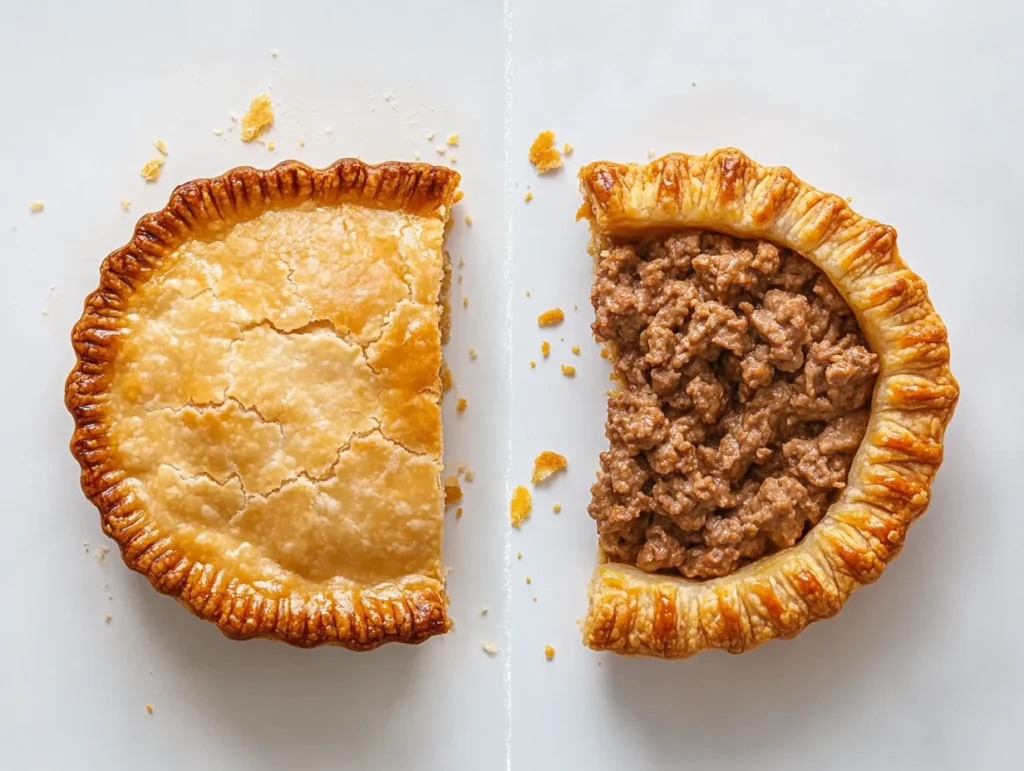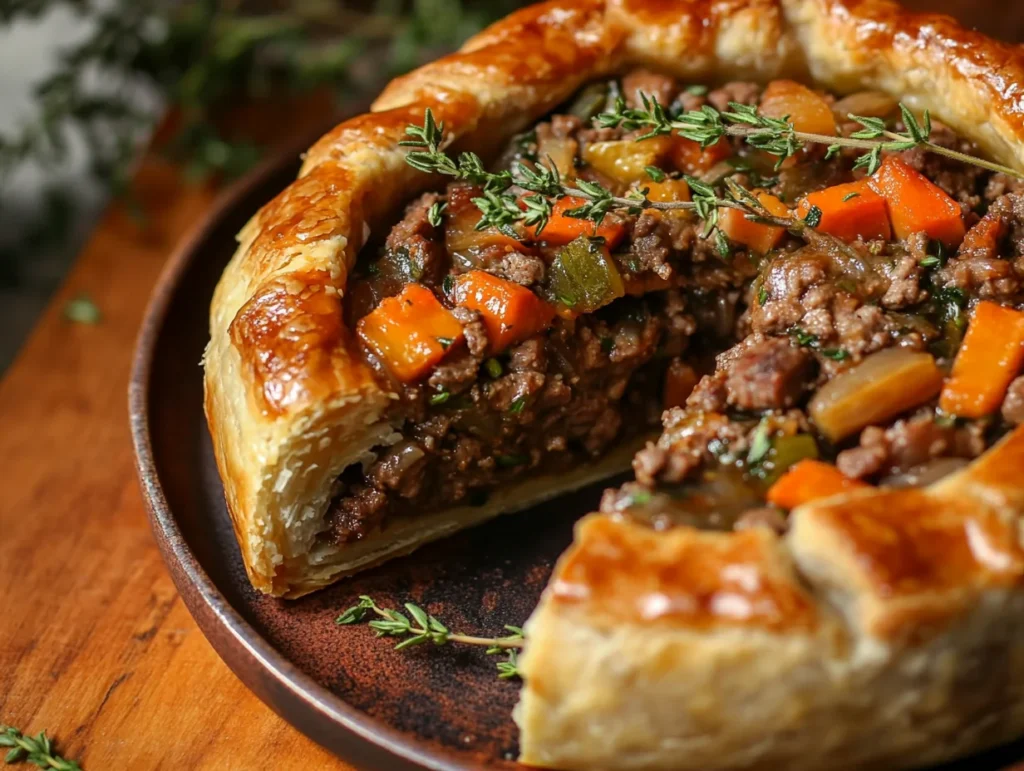When it comes to hearty, comforting dishes, people often debate the merits of pot pie and meat pie. Both are savory and satisfying, yet they have distinct differences in terms of crust, filling, and preparation. This article explores the key differences between these two beloved pies, helping you understand their unique features and decide which one is your favorite.
Historical Background: Origins of Pot Pies and Meat Pies
The origins of pot pie and meat pie trace back to different cultures, which shaped their unique characteristics. While pot pies evolved in America as a comforting dish, meat pies have long been staples in British and European culinary traditions.
The American Evolution of Pot Pie
In the United States, pot pie became a cherished comfort food. Early settlers, inspired by stews and casseroles, encased leftover meats and vegetables in pie crusts. As time went on, this method evolved into a staple dish, perfect for large family gatherings or cozy meals during colder months.
By the 20th century, frozen pot pies became widely available in grocery stores, offering unmatched convenience while retaining their comforting appeal. As a result, they became a go-to dinner option for many busy households.
Meat Pie: A European Staple with Global Appeal
On the other hand, meat pies have a rich history rooted in European cuisine, particularly in the United Kingdom. Designed initially as portable meals for workers and travelers, these pies were filled with meats and seasoned simply with herbs and spices. Over the years, they transformed from practical fare to beloved dishes in many households.
Classic variations such as steak and kidney pie and Cornish pasties became icons of British cuisine. Eventually, meat pies spread to regions like Australia and New Zealand, where local adaptations showcased their versatility. For more on traditional British meat pies, check out this guide on culinary traditions.
Crusts: The Foundation of Pot Pies and Meat Pies

The crust is a defining feature of both pot pie and meat pie. However, the differences in texture and construction highlight the unique character of each type of pie.
Pot Pie Crust: Flaky and Buttery
The crust of a pot pie typically features two layers—a bottom and a top crust. The bottom crust provides a sturdy base to support the filling, while the top crust offers a flaky, buttery texture that enhances the pie’s creamy interior. Together, these elements create a delightful balance of flavors and textures.
If you want to master the art of a flaky crust, check out this guide on how to make a flaky, perfect pie crust.
Meat Pie Crust: Sturdy and Functional
In contrast, the crust of a meat pie is usually single-layered and thicker. This sturdier design makes the pie easy to handle, especially for handheld consumption. Moreover, it prevents the pie from crumbling, ensuring a practical yet satisfying experience. Unlike the flaky crust of a pot pie, the meat pie crust emphasizes durability without compromising flavor.
Fillings That Make Each Pie Unique

The fillings of pot pie and meat pie are where their differences truly stand out. Both pies feature meat as a central ingredient, but their textures, flavors, and overall compositions set them apart.
Pot Pie: Creamy and Vegetable-Laden
A pot pie filling combines chunks of beef, chicken, or turkey with vegetables like carrots, peas, and potatoes. These ingredients are bound together by a rich, savory gravy, creating a creamy and hearty dish that satisfies both texture and flavor enthusiasts.
This luxurious filling pairs beautifully with the flaky crust, making pot pies a classic choice for family dinners and cozy meals.
Meat Pie: Simple and Meat-Centric
In comparison, the filling of a meat pie focuses on simplicity and the natural flavor of the meat. Minced beef, pork, or lamb forms the base of the dish, often seasoned with onions, garlic, and herbs like thyme or rosemary. Although some versions may include small amounts of vegetables, the emphasis remains on the meat itself.
Unlike pot pies, meat pies generally feature a solid, less saucy filling, making them perfect for those who prefer straightforward, savory flavors.
Popular Variations of Pot Pies and Meat Pies
Both pot pies and meat pies offer a variety of regional and creative adaptations, allowing for diverse tastes and ingredients.
Pot Pie Variations
- Classic Beef Pot Pie: A traditional recipe featuring beef, carrots, peas, and potatoes in a creamy gravy.
- Chicken Pot Pie: A lighter option that replaces beef with chicken while keeping the creamy vegetable base intact.
- Vegetarian Pot Pie: A plant-based version that uses mushrooms, tofu, and potatoes to replicate the hearty texture of traditional pot pies.
For a unique twist, try this leftover turkey and ham pot pie recipe.
Meat Pie Variations
- Steak and Kidney Pie: A British favorite combining beef steak and kidney in a savory gravy.
- Australian Meat Pie: A smaller, portable version filled with minced beef and a rich sauce.
- Tourtière: A French-Canadian variation that blends pork and beef, often seasoned with warm spices like cinnamon and cloves.
Serving Styles for Pot Pies and Meat Pies
The serving styles of pot pies and meat pies reflect their unique designs and cultural origins.
Pot Pies: Perfect for Family Meals
Pot pies are usually baked in a large dish, making them ideal for family-style meals. They are often sliced into portions and served with sides like salads or roasted vegetables. The double-crust design allows everyone to enjoy a combination of flaky pastry and creamy filling.
Meat Pies: Ideal for On-the-Go Eating
In contrast, meat pies are typically individual-sized, making them a convenient option for quick lunches or snacks. Their sturdy crust ensures they hold up well during travel, providing a practical yet flavorful meal for people on the go.
Cooking Pot Pies and Meat Pies at Home
How to Make a Delicious Pot Pie
- Prepare the filling: Brown chunks of beef, chicken, or turkey. Add carrots, peas, and potatoes, then create a creamy gravy using butter, flour, and stock.
- Prepare the crust: Roll out pie dough (store-bought or homemade). Line a pie dish with the bottom crust and add the filling.
- Bake: Cover with a top crust and bake at 375°F (190°C) for 35–40 minutes until golden brown.
Step-by-Step Meat Pie Recipe
- Prepare the filling: Brown minced beef, pork, or lamb. Add onions, garlic, and herbs, seasoning with a small amount of gravy or stock for flavor.
- Prepare the crust: Roll out dough, line the pie dish, and fill with the meat mixture. Cover with a top crust.
- Bake: Bake at 400°F (200°C) for 25–30 minutes until the crust is firm and golden.
Frozen vs. Homemade Pies: Pros and Cons
Why Frozen Pies Are Convenient
Frozen pies are a quick and easy solution for busy days. They can be baked straight from the freezer and still deliver a comforting meal. However, they often contain preservatives and lack the freshness of homemade versions.
Why Homemade Wins Every Time
Homemade pies allow for complete customization. You can choose high-quality ingredients, adjust seasonings, and avoid artificial additives. Although they take more time, the flavor and satisfaction of a freshly baked homemade pie are unparalleled.
Conclusion: Choosing Between Pot Pie and Meat Pie
Ultimately, the choice between pot pie and meat pie depends on your personal preferences. If you enjoy creamy, vegetable-filled dishes with a flaky crust, pot pie is the way to go. For those who prefer savory, meat-focused meals with a sturdier crust, meat pie is an excellent choice.
Both pies are versatile and satisfying, ensuring there’s always a perfect option for every craving.

